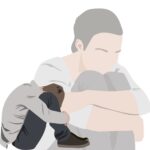One very common anxiety condition in kids is separation anxiety disorder (SAD). A person with SAD feels too much worry, concern, or even dread about being separated from an attachment figure, even if they are just going to be separated for a short time. It is normal for people to experience separation anxiety at certain stages of growth, but sometimes it shows up in the wrong way or at the wrong time. Separation anxiety that is normal for a child’s age shows up between 6 and 12 months. The normal or natural separation anxiety stays the same until the child is about 3 years old. It eventually goes away on its own, as it should. Large studies of whole populations show that up to 33.7% of people will experience an anxiety condition at some point in their lives. Other studies have shown that about one in four kids experiences worry as a child at some point between the ages of 13 and 18. On average, it starts around age 11 years. However, about 6% of kids ages 13 to 18 will have a serious anxiety condition at some point in their lives. In general, between 5.7% and 12.8% of children under 18 years old have it. Women are about twice as likely as guys to have this condition.
According to empirical evidence, separation anxiety disorder in youngsters makes both the child and the person caring for them feel bad. It can lead to excessive worry, social problems, sleep problems (like nightmares and peeing in bed), and several physical symptoms. If kids miss a lot of school, they might not do well in school and might not make friends. Adults with separation anxiety disorder may also develop other mental illnesses if they don’t get help.
Therefore, early detection and treatment of separation anxiety disorder is very important. This disorder can be detected with the help of the below-mentioned diagnostic criteria and features as outlined by DSM 5 TR:
Diagnostic Criteria
A. An excessive or developmentally inappropriate fear or worry about being away from the people they are close to, as shown by at least three of the following:
1. Recurrent excessive grief when expecting or having separation from residence or key attachment figures.
2. Constant and excessive worry about losing important people in your life or about harming them in some way, like getting sick, hurt, dying, or a natural disaster.
3. Constant and excessive worry about something bad happening (like getting lost, being taken, having an accident, or getting sick) that will separate them from a major attachment figure.
4. Reluctance or refusal to leave the house, whether it’s to school, work, or somewhere else, because of the fear of being alone.
5. Constant and strong anxiety or aversion to being by oneself or without important people in your life, whether at home or elsewhere.
6. Persistent unwillingness or refusal to sleep away from home or to go to sleep without being near a major attachment figure.
7. Repeated dreams involving the theme of separation.
8. Frequent reports of physical symptoms (such as headaches, stomachaches, nausea, and vomiting) when major attachment figures are going to be separated from the person or when they are already separated.
B. The fear, worry, or delay lasts for a long time; at least four weeks for kids and teens and usually six months or more for adults.
C. The disturbance leads to sadness or problems in social, academic, professional, or other important areas of functioning that are clinically relevant.
D. The problem cannot be explained by another mental condition, like refusing to leave the house because they don’t want to change too much if they have autism spectrum disorder or having delusions or dreams about being alone if they have schizophrenia.
For example, people with psychotic disorders might refuse to go outside without a trusted friend. People with a generalized anxiety disorder might worry that their loved ones will get sick or hurt, and people with an illness anxiety disorder might worry about getting sick themselves.
Diagnostic Features
- Separation anxiety disorder is characterized by excessive concern or worry about being away from home or loved ones.
- According to Criteria A, the person’s worry is excessive for their age and progress.
- At least three of these signs indicate a separation anxiety disorder.
- Traveling away from home or key people causes them too much worry (Criterion A1).
- They worry about attachment figures’ health or death, especially while apart. They need to locate and communicate with their attachment figures (Criterion A2).
- They also fear becoming lost, stolen, or having an accident and never seeing their primary bond figure again (Criterion A3).
- Separation anxiety disorder sufferers fear being alone and won’t go out alone (Criterion A4).
- They are continually and excessively terrified of being alone or without crucial home or outside connections.
- Separation anxiety disorder might prevent kids from leaving a place alone. They may also be “clingy,” “shadowing” a parent about the house, or wanting company when they walk to another room (Criterion A5).
- They always wish to sleep with a key bond figure or at home (Criterion A6).
- This disorder makes it hard for kids to fall asleep, so they may require a caregiver. They may sleep in their parent’s bed or a close relative’s bed.
- Kids may not want to camp, stay with friends, or do chores. Adults who travel alone and stay in hotels away from their families or loved ones may feel anxious.
- Separation anxiety may cause repeated nightmares of the family being destroyed by fire, murder, or other disasters (Criterion A7).
- When away from loved ones, children commonly experience headaches, stomachaches, nausea, and vomiting (Criterion A8).
- Heart disorders including palpitations, weakness, and fainting are rare in children but can affect teenagers and adults.
- Disturbance must continue for 4 weeks for children and teenagers under 18. It normally lasts 6 months for adults (Criterion B). However, the time necessary for persons should be considered as a guide with some leeway.
- Criteria C requires the disruption to produce sadness or issues in social, academic, occupational, or other clinically relevant performance domains.
I am a passionate and knowledgeable psychologist, with a Master of Philosophy (MPhil) in Psychology specializing in Counseling Psychology. Through my writing, I share my insights and thoughts on various psychiatric disorders, conduct analysis on films that touch on psychological issues, and explore other topics related to psychology, while also providing valuable information to psychology enthusiasts, students as well the general community.





